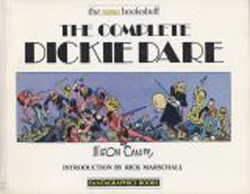
By Milton Caniff (Fantagraphics Books)
ISBN: 0-930193-22-9 (hardcover) ISBN: 0-930193-21-0 (softcover)
Milton Caniff wasn’t an overnight sensation. He worked long and hard before he achieved his stellar status in the comic strip firmament, before Terry and the Pirates brought him fame, and Steve Canyon secured his fortune. The strip which brought him to the attention of legendary Press Baron “Captain Joseph Patterson†– in many ways the co-creator of Terry – was an unassuming daily feature about a little boy who was hungry for adventure.
Caniff was working for The Associated Press as a jobbing cartoonist when a gap opened in their strips department. AP was an organisation that devised and syndicated features for the thousands of local and small newspapers which could not afford to produce the cartoons, puzzles, recipes and other fillers that ran between the local headlines and the regional sports.
Over a weekend Caniff came up with Dickie, a studious lad who would read a book and then fantasize himself into the story, taking his faithful little white dog “Wags†with him. The editors went for it and Dickie Dare began on July 31st, 1933. Caniff would write and draw the adventures for less than eighteen months before moving on, although his replacement Coulton Waugh steered the series until its conclusion two decades later.
The first day-dream was with Robin Hood, followed by a frantic, action-packed visit with Robinson Crusoe and Friday, battling hordes of yelling savages and scurvy pirates. Rugged combat gave way to fantastic mystery when he read Aladdin, resulting in a lavish and exotic trip to the fabled Far East. This adventure closed near Christmas, and when his father read Dickie the story of the Nativity, Caniff began his long tradition of creating seasonally topical strips. The visit to Bethlehem ended on Christmas morning, and one of Dickie’s presents triggers his next excursion, when he starts reading of General George Armstrong Custer.
King Arthur is next, followed by Captain Kidd the Pirate, but by then Caniff was chafing under the self-imposed limitations of his creation. The strip had become formulaic and there was no real tension or drama in mere dreams. In a creative masterstroke, he revised the strip’s parameters, and by so doing produced the prototype for a masterpiece.
On 11th of May, 1934, Dickie met his uncle, globe-trotting author and two-fisted man-of-action Dan Flynn, and one week later the pair embarked on a Round-the-World trip. Caniff had moved swiftly, crafting a template that would become Terry and the Pirates. The wide-eyed, nervy All-American kid with the capable adult pal and adventurer, whilst a subject of much controversy and even scurrilous modern disparagement was a literary archetype since before Treasure Island and adapting the relationship to comic-strips was commercially sound, a decision that would hit a peak of popularity with the horde of sidekicks/partners that followed in the wake of Robin the Boy Wonder six years later.
No sooner have Dickie and Dan taken ship for Africa than the drama begins, as restless Dickie discovers a hidden cargo of smuggled guns. Aided by feisty Debutante Kim Sheridan and sailor Algy Sparrow, they foil the scheme, but not before Dickie is captured by Kuvo, the Arab chieftain awaiting the guns. Pursued by the French authorities, Kuvo retreats to a desert fortress where Kim, disguised as a native slave-girl, rescues the lad, only to be caught herself. The full-tilt action comes to a splendid conclusion before the boys, with Algy in tow as butler, head for Tunis where they stumble across a plot to use a World War I U-Boat for ocean-going piracy.
This long adventure (beginning on September 13th) is a thoroughly gripping yarn that encompasses much of the Mediterranean and Atlantic, as the boys escape the pirates and aid the Navy in hunting down the villains. There’s loads of action and an astonishing amount of tension but the tale ends a tad abruptly when Caniff, lured away by Patterson, simply drops the feature and Coulton Waugh takes over the storyline on Monday 3rd December.
With no break in the tale Waugh rapidly (14 episodes) wraps up the saga, and even has Dickie home by Christmas. From the New Year the strip would chart new waters with Waugh at the helm, aided and briefly replaced by assistant and spouse Odin Burvik, whilst he wrote his seminal book on Comics and also when he was producing the strip Hank for the New York magazine PM. Dickie Dare eventually ended its run in October 1957 with the now adult adventurer beginning a new career as a US Navy Cadet.
Although usually dismissed as a mere stage on the road to his later mastery, and certainly long before Milton Caniff – and studio partner Noel Sickles – made the chiaroscurist breakthroughs in line-art that revolutionised the form, these tales of Dickie Dare should be appreciated on their own merits. Full of easy whimsy and charm the strip evolved into a rip-roaring, all-ages thriller, full of wit and derring-do, in many ways an American answer to Hergé’s Tintin. It’s long overdue for rediscovery by the mass-market, and while we’re at it, let’s see some of the work that the criminally under-valued Waugh originated too.
Artwork originally © 1933-1934 The Associated Press.
Other contents this edition © Richard Marschall All Rights Reserved.
